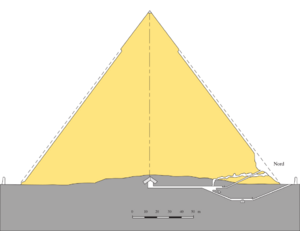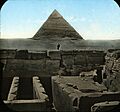Pyramid of Khafre facts for kids
Quick facts for kids Pyramid of Khafre |
|||||||||||||
|---|---|---|---|---|---|---|---|---|---|---|---|---|---|
 |
|||||||||||||
| Khafre | |||||||||||||
| Coordinates | 29°58′34″N 31°07′51″E / 29.97611°N 31.13083°E | ||||||||||||
| Ancient name |
Wr Ḫa-f-re Wer Khafre Great is Khafre |
||||||||||||
| Constructed | c. 2570 BC (4th dynasty) | ||||||||||||
| Type | True pyramid | ||||||||||||
| Height | Currently: 136.4 metres (448 ft) Original: 143.5 m (471 ft; 274 cu) |
||||||||||||
| Base | 215.25 metres (706 ft; 411 cu) | ||||||||||||
| Volume | 2,211,096 cubic metres (78,084,118 cu ft) | ||||||||||||
| Slope | 53°10' | ||||||||||||
The Pyramid of Khafre, also known as the Pyramid of Chephren, is an amazing ancient structure in Egypt. It's the middle of the three famous Pyramids of Giza. It's the second tallest and second largest pyramid in this group.
What makes it special is that it's the only one of the three Giza pyramids that still has some of its original smooth outer layer, called cladding, at the very top. This pyramid was built as a tomb for Khafre (also called Chefren). He was a pharaoh from the Fourth Dynasty who ruled around 2558 to 2532 BC.
Contents
How Big is Khafre's Pyramid?
This giant pyramid has a base that is about 215.5 meters (706 feet) long on each side. It reaches a height of about 136.4 meters (447 feet). That's like a 45-story building!
The pyramid is built from huge limestone blocks. Each of these blocks weighs more than 2 tons, which is heavier than a car! The sides of the pyramid rise at a steep angle of about 53 degrees. This is a bit steeper than its neighbor, the pyramid of Khufu.
Khafre's pyramid was built on a natural rock foundation. This foundation is about 10 meters (33 feet) higher than the ground around Khufu's pyramid. This makes Khafre's pyramid look even taller than it actually is!
A Look Inside the Pyramid
The Pyramid of Khafre has two entrances that lead to the burial chamber. One entrance is about 11.54 meters (38 feet) up on the north side of the pyramid. The other entrance is at the very bottom of the pyramid, also on the north side.
These passages don't go straight to the center of the pyramid. Instead, they are shifted about 12 meters (39 feet) to the east. The lower passage is carved right out of the solid rock beneath the pyramid. It goes down, then levels out, and then goes up to meet the horizontal passage that leads to the burial chamber.
There's also a smaller room connected to the lower passage. Experts aren't sure what this room was for. It might have been used to store offerings, burial items, or perhaps it was a special room called a serdab chamber. The upper passage is covered with granite and also leads to the burial chamber.
The Burial Chamber
The main burial chamber was carved out of a pit in the bedrock. Its roof is made of strong limestone beams that form a pointed shape, like a triangle. The room is rectangular, about 14.15 meters (46 feet) long and 5 meters (16 feet) wide. It runs from east to west.
Inside, you would have found Khafre's sarcophagus. This was a large coffin carved from a single block of granite. It was partly sunk into the floor. When explorer Giovanni Belzoni found it, it was empty except for some animal bones. There's also another pit in the floor. This pit probably held the canopic chest, which stored the pharaoh's internal organs.
You can also see two small rectangular holes in the walls of the burial chamber. These look a lot like the "air shafts" found in the Great Pyramid's burial chambers.
Pyramid Complex: What Else is There?
The Pyramid of Khafre wasn't just a single building. It was part of a larger complex, which included other important structures.
Satellite Pyramid
To the south of the main pyramid, there was once a smaller "satellite pyramid." Today, almost nothing is left of it except for some of its core blocks and the outline of its foundation. It had two passages leading inside, one of which ended in a dead end with a small space that held special ritual items.
Khafre's Temples
The temples connected to Khafre's pyramid are much better preserved than those of Khufu's pyramid. Especially the Valley Temple, which is still mostly standing.
To the east of the main pyramid was the mortuary temple. Even though it's mostly in ruins now, we can still see its original layout. This temple was larger than earlier ones and was the first to include five main parts: an entrance hall, a court with columns, five special spaces for statues of the pharaoh, five storage rooms, and an inner holy area. It's believed there were over 50 life-sized statues of Khafre here!
A long walkway, about 494.6 meters (541 yards) long, connected the mortuary temple to the valley temple. The valley temple is very similar to the mortuary temple. It was built from huge blocks of stone, some weighing over 100 tons! Its inside was made of red granite and the floor was paved with shiny alabaster.
The valley temple had two doors leading into a lobby and a large hall with columns. There were spaces on the floor where 23 statues of Khafre once stood. The inside of the Valley Temple, made of granite, is still in great condition.
The Sphinx Temple
There's also a temple often called the "temple of the Sphinx." We don't know for sure which king built it, but it looks very similar to Khafre's mortuary temple. This suggests he might have built it. It has a hall with 24 columns, each possibly holding a statue, and two holy areas.
The Great Sphinx

The famous Great Sphinx of Giza might have been part of Khafre's pyramid complex. The Sphinx was carved directly out of a large rock formation. This same rock formation was also used to get some of the stone blocks for building the pyramid itself.
Images for kids
-
Khafre Enthroned, one of the statues of the Valley Temple
See Also
- Egyptian pyramid construction techniques
- List of Egyptian pyramids
- List of megalithic sites
- List of tallest structures built before the 20th century















